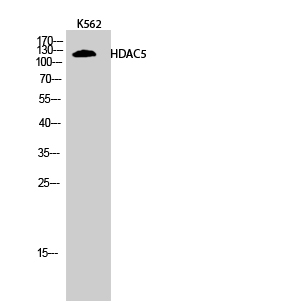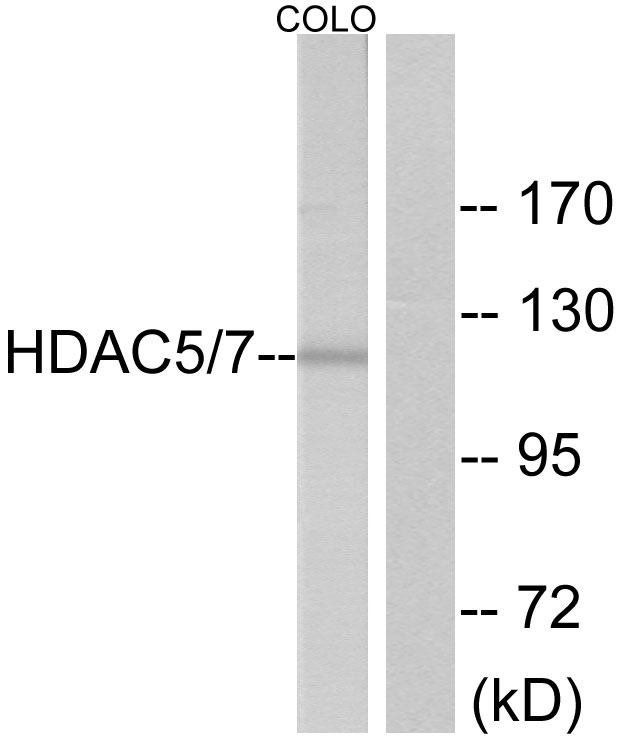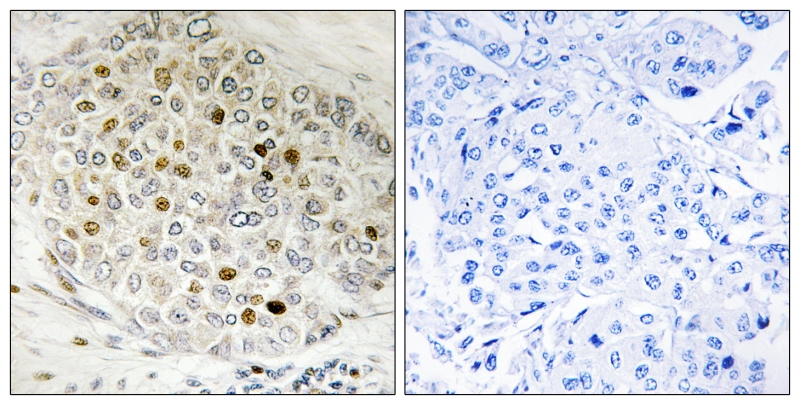



| WB | 1/500-1/1000 | Human,Mouse,Rat |
| IF | 咨询技术 | Human,Mouse,Rat |
| IHC | 1/50-1/100 | Human,Mouse,Rat |
| ICC | 1/50-1/200 | Human,Mouse,Rat |
| FCM | 咨询技术 | Human,Mouse,Rat |
| Elisa | 1/10000 | Human,Mouse,Rat |
| Aliases | HD5; NY-CO-9 |
| Entrez GeneID | 10014 |
| WB Predicted band size | Calculated MW: 122 kDa; Observed MW: 122 kDa |
| Host/Isotype | Rabbit IgG |
| Antibody Type | Primary antibody |
| Storage | Store at 4°C short term. Aliquot and store at -20°C long term. Avoid freeze/thaw cycles. |
| Species Reactivity | Human,Mouse |
| Immunogen | The antiserum was produced against synthesized peptide derived from human HDAC5. AA range:464-513 |
| Formulation | Purified antibody in PBS with 0.05% sodium azide,0.5%BSA and 50% glycerol. |
+ +
以下是关于HDAC5抗体的3篇参考文献示例(注:文献为示例性内容,实际引用需核实原文):
---
1. **文献名称**:*"HDAC5 modulates chromatin accessibility and transcriptional regulation in cardiomyocytes"*
**作者**:Wang, Y., et al.
**摘要**:本研究利用HDAC5特异性抗体通过染色质免疫沉淀(ChIP)和Western blot技术,揭示了HDAC5在心肌细胞染色质重塑中的关键作用,验证了抗体在检测内源性HDAC5蛋白表达及定位中的高特异性。
---
2. **文献名称**:*"Antibody validation for HDAC5 in neuronal differentiation models"*
**作者**:Chen, L., & Thompson, R.
**摘要**:通过比较多种商业HDAC5抗体的性能,作者筛选出适用于免疫荧光和流式细胞术的高效抗体,并证实其在神经干细胞分化模型中检测HDAC5动态表达的可靠性。
---
3. **文献名称**:*"HDAC5-mediated epigenetic silencing promotes breast cancer metastasis"*
**作者**:Gupta, S., et al.
**摘要**:研究使用HDAC5抗体进行组织微阵列(TMA)免疫组化分析,发现HDAC5在乳腺癌转移组织中的异常高表达,提示其作为预后标志物的潜力,同时验证了抗体在临床样本中的适用性。
---
如需实际文献,建议在PubMed或Google Scholar中搜索关键词“HDAC5 antibody validation”或“HDAC5 antibody application”,并筛选近5年高被引论文。抗体供应商(如CST、Abcam)官网也可能提供已验证的参考文献列表。
HDAC5 (Histone Deacetylase 5) is a member of the class IIa histone deacetylase family, which plays a critical role in epigenetic regulation by removing acetyl groups from histone proteins. This enzymatic activity promotes chromatin condensation, leading to transcriptional repression. HDAC5 is involved in diverse cellular processes, including cell differentiation, metabolism, apoptosis, and stress response. It interacts with transcription factors and co-repressors (e.g., MEF2. SIRT1) to modulate gene expression, particularly in tissues like the heart, brain, and skeletal muscle. Dysregulation of HDAC5 has been linked to cancer progression, cardiovascular diseases, and neurological disorders, making it a therapeutic target of interest.
HDAC5 antibodies are essential tools for studying its expression, localization, and function. They enable detection via techniques like Western blotting, immunofluorescence, and immunohistochemistry. Specific antibodies can distinguish HDAC5 from other HDAC isoforms (e.g., HDAC4 or HDAC7) by targeting unique epitopes within its N-terminal regulatory domain or C-terminal catalytic domain. Validated antibodies are crucial for assessing post-translational modifications (e.g., phosphorylation at Ser259/Ser498) that regulate its nucleocytoplasmic shuttling. Researchers also use HDAC5 antibodies in chromatin immunoprecipitation (ChIP) to map its genomic binding sites. High-quality antibodies with confirmed specificity (e.g., via knockout validation) ensure reliability in both basic research and drug development studies.
×